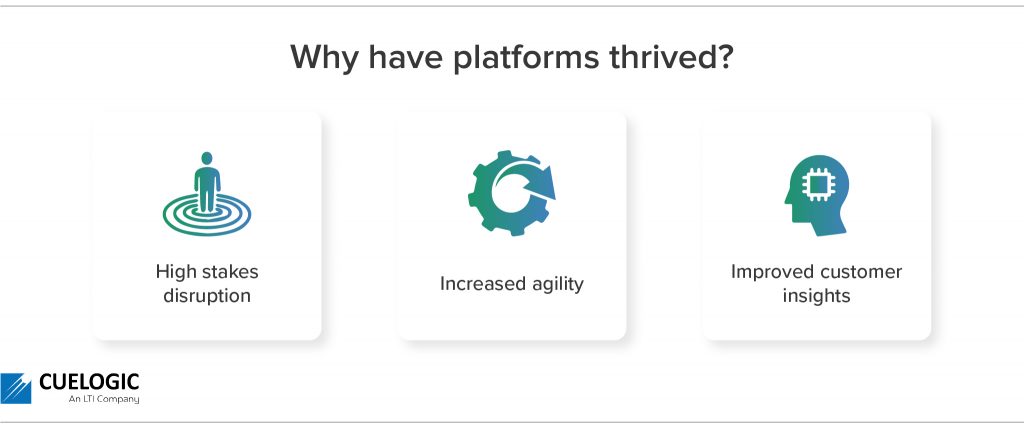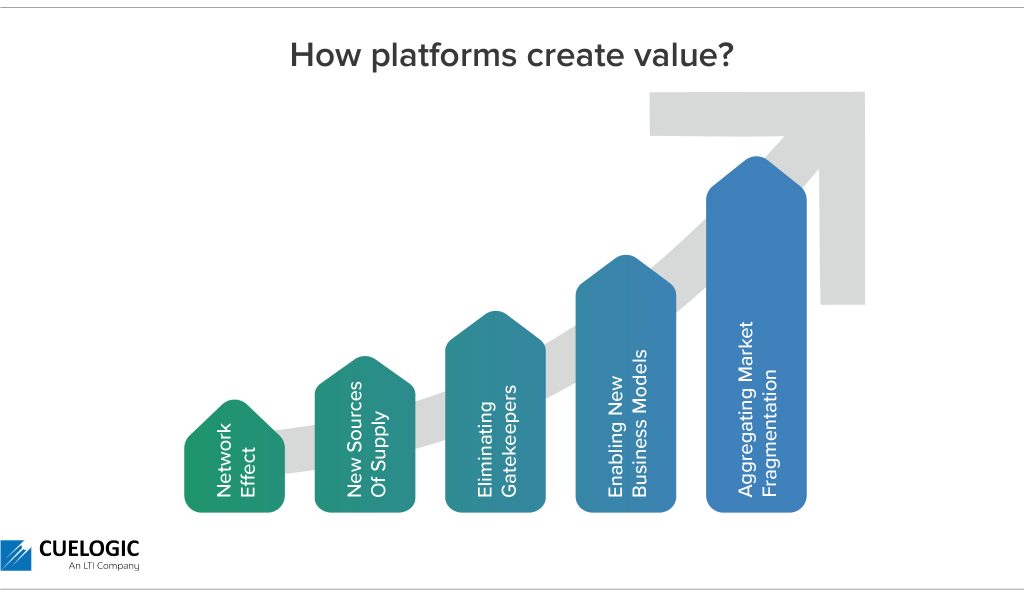The platform economy is a disruption that is proving to deliver far-sighted benefits for enterprises, small and large. After years in the making, the platform ecosystem is finally stepping up to transform the corporate backdrop as we know it. This blog discusses how the platform economy is shaking up enterprises and what this means for your business going forward.
The Rise of the platform economy
There are 500+ companies today valued at over $1 Billion in the US alone, many of which are platform businesses. Moreover, the growth trajectory indicates that the number of platforms in the top 500 US stocks has increased from a mere 40 to a substantial 100 in just a decade. Such proliferation of platform businesses in every sphere of the economy is indicative of a platform revolution.
In the new age, enterprises are being disrupted by nimble-footed start-ups that offer a platform-based business solution. This is not to say that the incumbent companies have become obsolete; instead, they are forced to adapt and change their business models to compete.
How companies are witnessing multi-fold value with platforms
Platforms are essentially functioning as ‘the wake of the 21st Century for archaic industries, making them new again. Take, for instance, how Uber disrupted the taxi industry or how Airbnb has changed the hospitality landscape. These companies have created a new market by establishing two-faceted platforms that bridge the demand with the supply sides.
Not only has this unlocked a new way of looking at customer values, but also driven fresh perspectives of customer relationships along with an influx of new, asset-light value-creation. The tangible and exponential results warrant an overhaul of the entire business model and its value propositions.
Shift from traditional business models to platform business models
Traditional business models have always been based on linear value propositions. However, in a platform economy, the focus is on curating interactions between stakeholders on all sides of the value chain. This has led to the rise of network effects and the need to adapt the business model accordingly.
Why archaic B-models have failed in the platform economy
Business models are undergoing a tectonic shift from ‘Product to Platform.’ This means that the very definition of value is changing in the wake of a ‘multi-sided’ nature of value creation. And there have been many reasons driving this change:
Rigid demarcation between products and services:
Traditional business models focusing exclusively on products have been vulnerable to ever-changing customer needs and wants. The lines between what is a product and what is a service has become blurred, making it hard to pinpoint one’s core business today. Inflexibility models are no longer suitable for the dynamic nature of the platform economy, making platforms a natural choice for enterprises.
Lack of perspective in dynamic markets:
When looking at new opportunities, most leaders instinctively prioritize the comfort zone of existing sales over the cold showers of innovation. The fact that newer, better business models are viewed as competition is indicative that the current business model is losing relevance.
Dependence on single-sided dominance:
The one-way nature of archaic business models has made them vulnerable to being disrupted by multi-sided platforms. Such business models are free to collaborate on a particular value proposition, creating mutual utility and unlocking new markets.
Aggressive ROI bottlenecks:
New business models are often subject to existing financial metrics and ROI hurdles, practically creating roadblocks that stunt innovation. This makes organizations even more resistant to change and kills off the very environment that is necessary for new business models to thrive.
Why have platforms thrived?
The success of platforms has been driven by their ability to transcend the artificial boundaries that once existed in product-centric business models. By leveraging multi-sided relationships, platforms have made room for entirely new value propositions and ways of looking at customer needs. And there are strong reasons why:

High stakes disruption:
Platforms have been able to leverage the network effect to its full potential, thereby creating a virtuous circle of growth. This has allowed them to achieve scale at an unprecedented rate, something that was unthinkable in the age of traditional business models.
Increased agility:
Platforms have been able to move faster than their linear counterparts, thanks to the modular nature of their value propositions. This has allowed them to quickly adapt to changing customer needs and market trends, giving them a significant competitive advantage.
Improved customer insights:
With their multi-sided nature, platforms can unlock new opportunities in customer feedback and insights through the aggregation of data. This is not only vital for the platform itself but also for the ecosystem of partners and developers that it supports.
Types Of Platforms
Several types of platforms have formed the backbone of some of the most successful organizations today. These include:
Innovation or technology platforms:
These are aimed to create new industries by fostering innovation from the ground up. Typically, these platforms build and develop the foundation that other innovators can use to design and create complementary innovations.
Service or application platforms:
These platforms provide tools or services that developers can use to build new applications. Depending on the platform’s business model, these can be either open or closed.
Communication platforms:
These platforms provide the infrastructure that enables the communication between different parties. This can be in the form of messaging, telephony, or even video conferencing.
Transaction or digital platforms:
These platforms are designed to facilitate transactions between two or more parties. This platform has been at the core of some of the biggest success stories in digital commerce, such as Amazon, eBay, and Uber.
How platforms create value
Typically, platforms look at the same set of challenges with a different set of eyes. This allows them to unlock new sources of value by:

- Network effect: Platforms go beyond pipeline models by creating a network of partners that can mutually benefit from each other’s innovations. This network effect indicates that the platform’s value increases exponentially as more and more participants join the ecosystem.
- Eliminating gatekeepers: Platforms replace traditional gatekeepers and lower the barriers in the value chain by reducing transaction costs and process friction.
- Enabling new business models: Platforms enable the development of new business models by providing a flexible infrastructure that can be adapted to changing needs.
- Aggregating market fragmentation: Highly fragmented markets often suffer from issues related to liquidity and reach. Platforms can aggregate this market fragmentation and provide a single access point for buyers and sellers.
- New sources of supply: Platforms tap into underutilized market sources of supply, such as latent inventories, idle capacity, individual creators, niche markets, or under-served communities.
In many cases, a combination of these factors has allowed platforms to create unprecedented value.
Conclusion
The rise of platforms has been pivotal in the disruptions of many industries, with platform companies even outperforming the stock market on many occasions. As platforms continue to evolve and adapt, we are likely to see even more value-creating opportunities emerge in the future.
